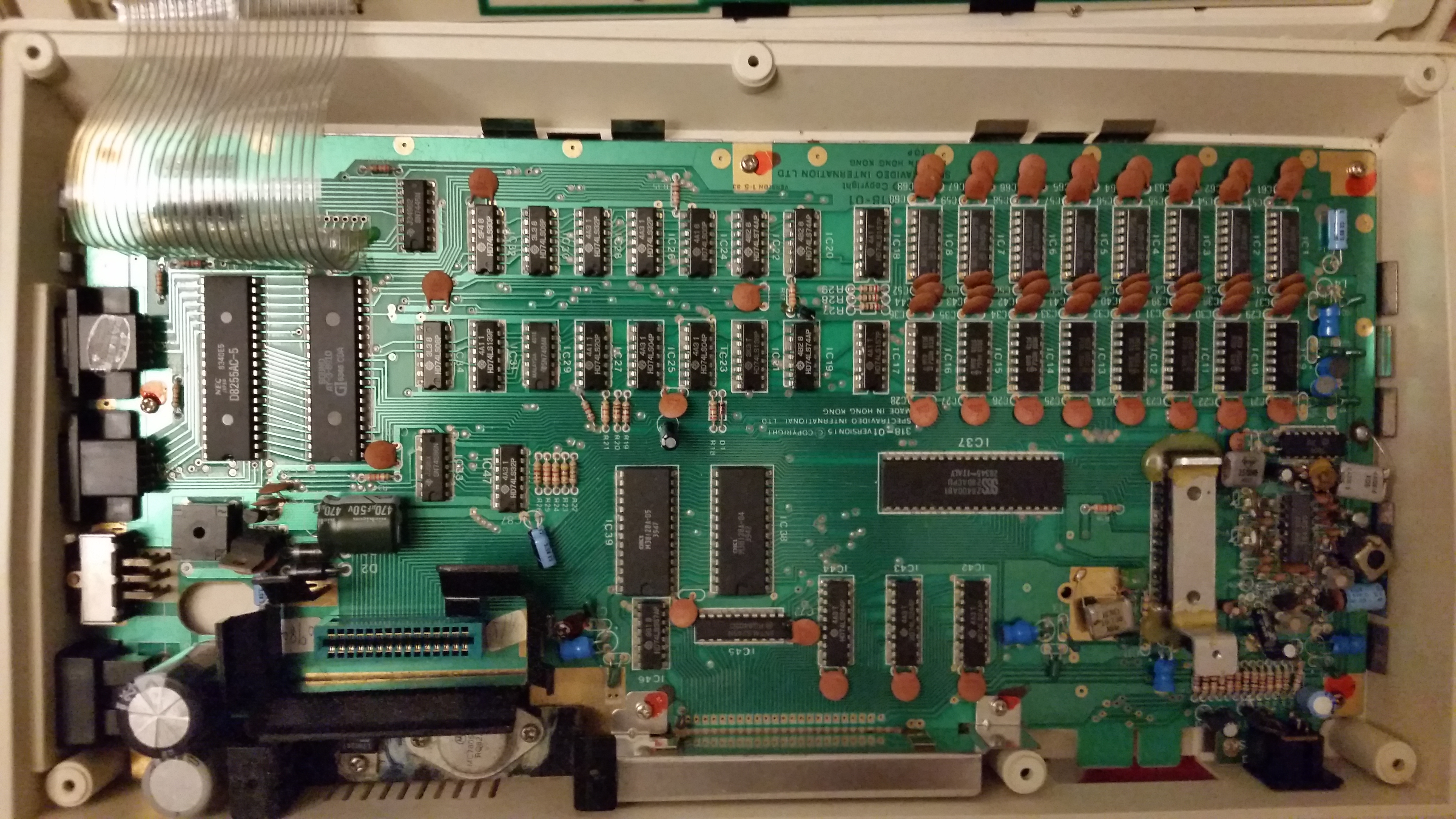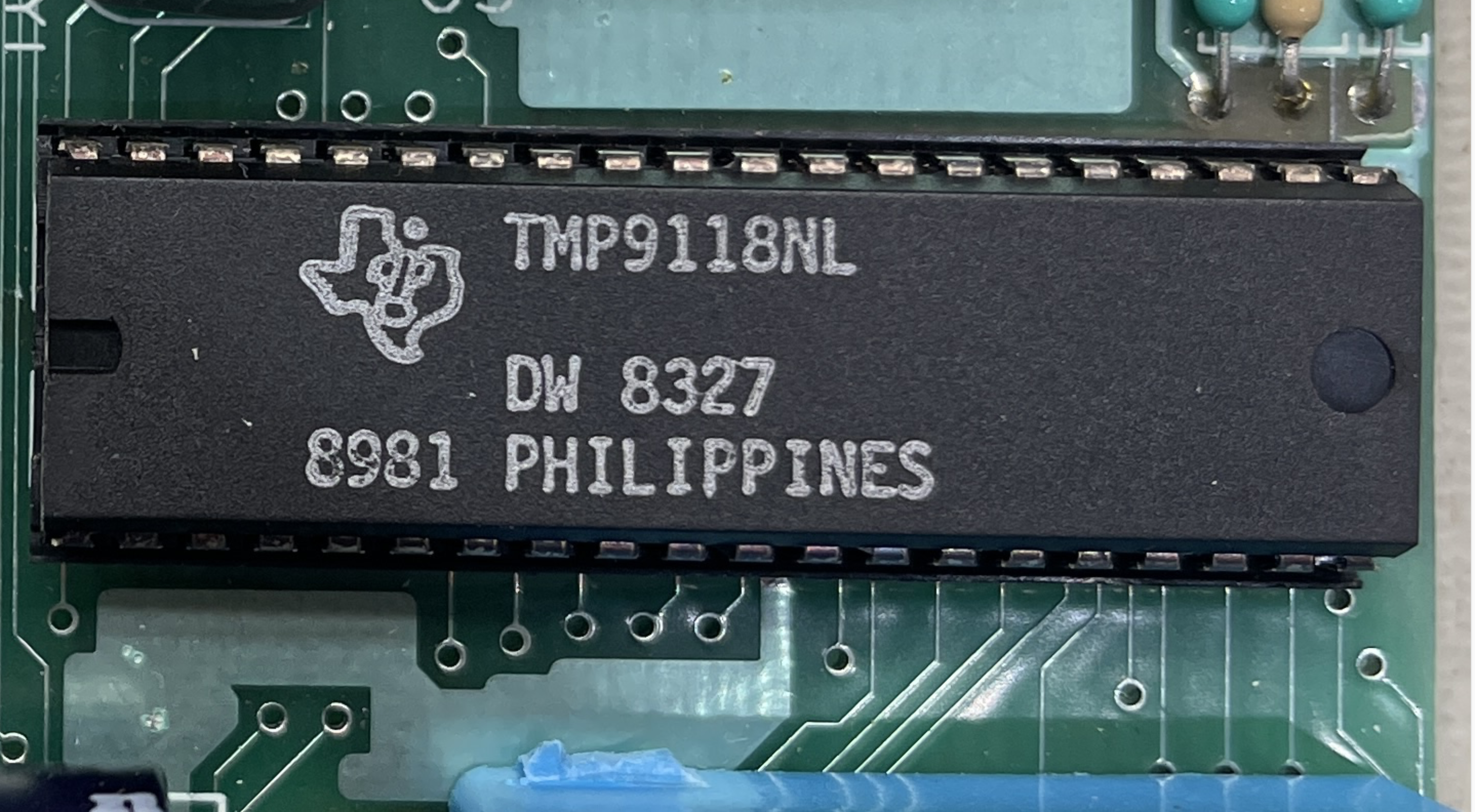|
SV-318
The SV-318 is the basic model of the Spectravideo range. It was fitted with a chiclet style keyboard, which was difficult to use, alongside a combination cursor pad/joystick. This is a disc-shaped affair with a hole in the centre; put a red plastic 'stick' in the hole and with a built-in joystick, remove the stick and it is a directional arrow pad for word processing etc. This machine also had only 16 KB of user RAM (plus an additional 16 KB of video RAM), which limited its usefulness. However, this could be expanded via an external peripheral box. This machine is basically identical to its big brother the SV-328, the only differences being in the keyboard and amount of memory. The two machine's ROM, expandability, mainboard and case were identical. Reference to the operating system Microsoft Extended BASIC is not to be confused with MSX BASIC, although some marketing at the time claimed that Microsoft Extended is what MSX stood for. The SV-318 is not fully complian ... [...More Info...] [...Related Items...] OR: [Wikipedia] [Google] [Baidu] |
Spectravideo SVI318
Spectravideo International Limited (SVI) (printed as Spectra Video, with the space, in game manuals) was an American computer manufacturer and software house. It was originally called SpectraVision, a company founded by Harry Fox in 1981. The company produced video games and other software for the VIC-20 home computer, the Atari 2600 home video game console, and its CompuMate peripheral. Some of their own computers were compatible with the Microsoft MSX or the IBM PC. Despite their initial success, the company faced financial troubles, and by 1988, operations ceased. Later, a UK-based company bought the Spectravideo brand name from Bondwell in 1988, but this company, known as Logic3, had no connection to the original Spectravideo products and was dissolved in 2016. History SpectraVision was founded in 1981 by Harry Fox and Alex Weiss as a distributor of computer games, contracting external developers to write the software. Their main products were gaming cartridges for ... [...More Info...] [...Related Items...] OR: [Wikipedia] [Google] [Baidu] |
Spectravideo
Spectravideo International Limited (SVI) (printed as Spectra Video, with the space, in game manuals) was an American computer manufacturer and software house. It was originally called SpectraVision, a company founded by Harry Fox in 1981. The company produced video games and other software for the VIC-20 home computer, the Atari 2600 home video game console, and its CompuMate peripheral. Some of their own computers were compatible with the Microsoft MSX or the IBM PC. Despite their initial success, the company faced financial troubles, and by 1988, operations ceased. Later, a UK-based company bought the Spectravideo brand name from Bondwell in 1988, but this company, known as Logic3, had no connection to the original Spectravideo products and was dissolved in 2016. History SpectraVision was founded in 1981 by Harry Fox and Alex Weiss as a distributor of computer games, contracting external developers to write the software. Their main products were gaming cartridges fo ... [...More Info...] [...Related Items...] OR: [Wikipedia] [Google] [Baidu] |
SV-328
The SV-328 is an 8-bit home computer introduced by Spectravideo in June 1983. It was the business-targeted model of the Spectravideo range, sporting a compact full-travel keyboard with numeric keypad. It had 80 KB Random-access memory, RAM (64 KB available for software, remaining 16 KB video memory), a respectable amount for its time. Other than the keyboard and RAM, this machine was identical to its little brother, the SV-318. The SV-328 is the design on which the MSX standard was based. Spectravideo's MSX-compliant successor to the 328, the SV-728, looks almost identical, the only immediately noticeable differences being a larger cartridge slot in the central position (to fit MSX standard cartridges), lighter shaded keyboard and the MSX badging. Reference to the operating system Microsoft BASIC, Microsoft Extended BASIC is not to be confused with MSX BASIC, although some marketing at the time claimed that Microsoft Extended is what MSX stood for. More than 130 ga ... [...More Info...] [...Related Items...] OR: [Wikipedia] [Google] [Baidu] |
TMS9918
IMAGE:TMS9918A 01.jpg, VDP TMS9918A IMAGE:TMS9918A 02.jpg, VDP TMS9918A The TMS9918 is a video display controller (VDC) manufactured by Texas Instruments, in manuals referenced as "Video Display Processor" (VDP) and introduced in 1979. The TMS9918 and its variants were used in the PV-2000, Casio PV-2000, Coleco Adam, ColecoVision, VTech CreatiVision, CreatiVision, Hanimex, Hanimex Pencil II, MSX, Memotech MTX, NABU Network#Hardware, NABU Personal Computer, Programa Educativo de Colegios Secundarios, PECOS, SG-1000, SC-3000, SV-318, SV-328, Sord M5, TI-99/4A, TI-99/4, Tatung Einstein, and Tomy Tutor. The TMS9918 generates both grid-based character graphics (used to display text or background images) and sprite (computer graphics), sprites used for moving foreground objects. The key features of this chip are, as highlighted in a 1980 presentation by Karl Guttag (one of the designers): *256 by 192 full color pixels per screen *15 different colors and/or shades *Progressive scan, Non ... [...More Info...] [...Related Items...] OR: [Wikipedia] [Google] [Baidu] |
ColecoVision
ColecoVision is a second-generation home video-game console developed by Coleco and launched in North America in August 1982. It was released a year later in Europe by CBS Electronics as the CBS ColecoVision. The console offered a closer experience to more powerful arcade video games compared to competitors such as the Atari 2600 and Intellivision. The initial catalog of twelve games on ROM cartridge included the first home version of Nintendo's ''Donkey Kong'' as the pack-in game. Approximately 136 games were published between 1982 and 1984, including Sega's '' Zaxxon'' and some ports of lesser known arcade games that found a larger audience on the console, such as '' Lady Bug'', '' Cosmic Avenger'', and '' Venture''. Coleco released a series of hardware add-ons and special controllers to expand the capabilities of the console. "Expansion Module #1" allowed the system to play Atari 2600 cartridges. A later module converted ColecoVision into the Adam home computer. ColecoVisi ... [...More Info...] [...Related Items...] OR: [Wikipedia] [Google] [Baidu] |
Chiclet Keyboard
A chiclet keyboard is a computer keyboard with keys that form an array of small, flat rectangular or lozenge-shaped rubber or plastic keys that look like erasers or " Chiclets", a brand of chewing gum manufactured in the shape of small squares with rounded corners. It is an evolution of the membrane keyboard, using the same principle of a single rubber sheet with individual electrical switches underneath each key, but with the addition of an additional upper layer which provides superior tactile feedback through a buckling mechanism. The term "chiclet keyboard" is sometimes incorrectly used to refer to island-style keyboards. Since the mid-1980s, chiclet keyboards have been mainly restricted to lower-end electronics, such as small handheld calculators, cheap PDAs and many remote controls, though the name is also used to refer to scissor keyboards with superficially similar appearance. History The term first appeared during the home computer era of the late 1970s to mid-1 ... [...More Info...] [...Related Items...] OR: [Wikipedia] [Google] [Baidu] |
Microsoft BASIC
Microsoft BASIC is the foundation software product of the Microsoft company and evolved into a line of BASIC interpreters and compiler(s) adapted for many different microcomputers. It first appeared in 1975 as Altair BASIC, which was the first version of BASIC published by Microsoft as well as the first high-level programming language available for the Altair 8800 microcomputer. During the home computer craze of the late-1970s and early-1980s, Microsoft BASIC was ported to and supplied with many home computer designs. Slight variations to add support for machine-specific functions, especially graphics, led to a profusion of related designs like Commodore BASIC and Atari Microsoft BASIC. As the early home computers gave way to newer designs like the IBM Personal Computer and Macintosh, BASIC was no longer as widely used, although it retained a strong following. The release of Visual Basic rebooted its popularity and it remains in wide use on Microsoft Windows platforms in its m ... [...More Info...] [...Related Items...] OR: [Wikipedia] [Google] [Baidu] |
Computer Keyboard
A computer keyboard is a built-in or peripheral input device modeled after the typewriter keyboard which uses an arrangement of buttons or Push-button, keys to act as Mechanical keyboard, mechanical levers or Electronic switching system, electronic switches. Replacing early punched cards and paper tape technology, interaction via teleprinter-style keyboards have been the main input device, input method for computers since the 1970s, supplemented by the computer mouse since the 1980s, and the touchscreen since the 2000s. Keyboard keys (buttons) typically have a set of characters Engraving, engraved or Printing, printed on them, and each press of a key typically corresponds to a single written symbol. However, producing some symbols may require pressing and holding several keys simultaneously or in sequence. While most keys produce character (computing), characters (Letter (alphabet), letters, Numerical digit, numbers or symbols), other keys (such as the escape key) can prompt the ... [...More Info...] [...Related Items...] OR: [Wikipedia] [Google] [Baidu] |
Computer Memory
Computer memory stores information, such as data and programs, for immediate use in the computer. The term ''memory'' is often synonymous with the terms ''RAM,'' ''main memory,'' or ''primary storage.'' Archaic synonyms for main memory include ''core'' (for magnetic core memory) and ''store''. Main memory operates at a high speed compared to mass storage which is slower but less expensive per bit and higher in capacity. Besides storing opened programs and data being actively processed, computer memory serves as a Page cache, mass storage cache and write buffer to improve both reading and writing performance. Operating systems borrow RAM capacity for caching so long as it is not needed by running software. If needed, contents of the computer memory can be transferred to storage; a common way of doing this is through a memory management technique called ''virtual memory''. Modern computer memory is implemented as semiconductor memory, where data is stored within memory cell (com ... [...More Info...] [...Related Items...] OR: [Wikipedia] [Google] [Baidu] |
Random-access Memory
Random-access memory (RAM; ) is a form of Computer memory, electronic computer memory that can be read and changed in any order, typically used to store working Data (computing), data and machine code. A random-access memory device allows data items to be read (computer), read or written in almost the same amount of time irrespective of the physical location of data inside the memory, in contrast with other direct-access data storage media (such as hard disks and Magnetic tape data storage, magnetic tape), where the time required to read and write data items varies significantly depending on their physical locations on the recording medium, due to mechanical limitations such as media rotation speeds and arm movement. In today's technology, random-access memory takes the form of integrated circuit (IC) chips with MOSFET, MOS (metal–oxide–semiconductor) Memory cell (computing), memory cells. RAM is normally associated with Volatile memory, volatile types of memory where s ... [...More Info...] [...Related Items...] OR: [Wikipedia] [Google] [Baidu] |
BASIC
Basic or BASIC may refer to: Science and technology * BASIC, a computer programming language * Basic (chemistry), having the properties of a base * Basic access authentication, in HTTP Entertainment * Basic (film), ''Basic'' (film), a 2003 film * Basic, one of the Galactic Basic, languages in ''Star Wars'' Music * Basic (Glen Campbell album), ''Basic'' (Glen Campbell album), 1978 * Basic (Robert Quine and Fred Maher album), ''Basic'' (Robert Quine and Fred Maher album), 1984 * B.A.S.I.C. (Alpinestars album), ''B.A.S.I.C.'' (Alpinestars album), 2000 * Basic (Brown Eyed Girls album), ''Basic'' (Brown Eyed Girls album), 2015 * B.A.S.I.C. (The Basics album), ''B.A.S.I.C.'' (The Basics album), 2019 Places * Basic, Mississippi, a community in the US * BASIC countries, Brazil, South Africa, India and China in climate change negotiations Organizations * BASIC Bank Limited, government owned bank in Bangladesh * Basic Books, an American publisher Other uses * Basic (cigarette), a brand ... [...More Info...] [...Related Items...] OR: [Wikipedia] [Google] [Baidu] |








